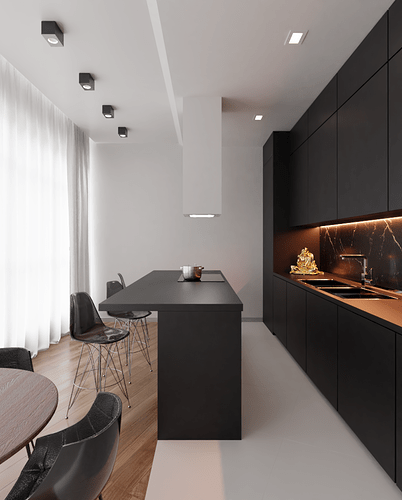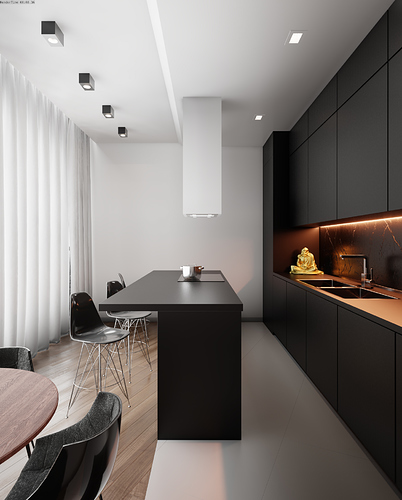You are welcome)
@marcoG_ita is right, for a scene so simple 30 minutes at that resolution are many.
In fact, I looked at the file. 5000 samples are a lot…
Despite everything, with E-Cycles it takes 25 minutes with a Gtx1080 + i7 7700.
Taking 2500 samples (which is already a high value for the scene) we go down to 11 minutes.
Gragh_Sparrow,
Thanks for the test file. I did the cycles render and it looks exactly like the Lux.png at the top of your post without the blown out curtain light of the Cycles.png. I think you have reverse the Lux.png with the Cycles.png.
If you look at the black or white ceiling, then there are visible stains after denoise. Could you show what you can do in 11 minutes?
In general, if you do not mind, in this answer, I will express my opinion on the engines.
Until recently, I tried to find the advantages of Cycles, I am not talking about the obvious now - if there is a scene with some very complex material, or I need to do something procedural, then I think it will be easier to implement in Cycles - it is much more flexible in management.
But what a minus I notice is the setting of the light. On the one hand, it is flexible, I see everything that I do, but does it work out as I would like, does it work out as in the other two engines? In my opinion, no, the light in Cycles is spreading as if gently, spreading everywhere. Also, I always have the feeling that the lines and the picture as a whole are kind of “soft” in comparison with the crown, and even with the lux. I also want to note that I think the picture is less natural. According to my feelings, this is caused by greater saturation and “softness.” Of course, this is all subjective and I also do not deny that it is possible to adjust all this in Cycles, but the question is what needs to be done to do this. I have suspicions that this “softness” is caused by the fact that denoise works this way, because even when it does not leave stains, it still cleans up a lot of noise.
Lux, in turn, makes it very easy to set up a very pleasant material, immediately gives you a nice picture, realistic, as it seems to me. But for now, long enough, considering that the denoiser is worse than in the Cycles. I also like the setting of the light, it’s also soft, but it doesn’t spread everywhere, the light groups are also comfortable.
The disadvantages are the advantages of Cycles - at least for me, I am not very well versed in all the possibilities of textures and combinations of nodes.
In general, it seems to me that it is easy to make a natural picture in it and this could be completed if there were no Corona.
You can attribute the advantages of a Lux to Corona, but not fully if there is a Lux nearby. Corona allows you to customize the material as you need, but despite the fact that there are more sliders than in the Lux - Corona seems more sensitive to tuning than Lux. To make it material that will also be pleasant, I need a little more time. As for the light - it seems more rigid, but at the same time it is not limited to anything, the picture is realistic, as if it were something between lux and Cycles. Textures were drawn in those 30 minutes more clearly than in other competitors.
I can say one thing about the light and materials - they are easier to set up than in Cycles - focusing on realism, but at the same time you need to adapt yourself, because it’s like a big range in which you need to clearly get to the right place, but then you will immediately get what is needed, although the toolkit itself is modest.
And also the speed, so far the speed displaces the rest very much. You can say that in Cycles can not put a lot of samples. But when a client wants a clean picture, you will not tell him that that’s enough and so much.
The downsides to me are the same flexibility, which is also limited by the fact that there is no full-fledged adaptation, as well as difficulties with the same procedural steps.
In short, when I make orders that often do not require artistic rendering, speed and convenience prevail, but at the same time we are striving for realism. I am familiar with Lux recently and only open it for myself. I know Corona longer
I myself have been doing 3d more than a year.
He didn’t… I have lux scene open now and table is clearly different from cycles… A strong hint is also the terrible denoising artifacts from BCD in the shadow areas from luxcore… it’s a tragedy 
lacilaci86 already said in front of me, add a crooked bump on the table and chair, they will not allow to be mistaken
I don’t want to give some unsolicited advice but I hope you don’t mind.
I opened your lux scene to see what can be optimized…
I’m now rendering
with clamping at 1000
camera tonemapper settings are set to: camera settings Fstop 2.80/shutter 0.02 and ISO 800
environment gain at 1000
disable BCD denoiser and rather use Declan Russel’s nvidia denoiser(it’s not great but better than BCD)
Should be enough speedup to get you down to ~20 min (I’m guessing, I don’t know how well your HW will perform)
Of course, thanks for the advice, it’s good when the clues come themselves, and are not randomly found on the Internet))
Graph_Sparrow,
This is the cycles render at 50% output with Blender 2.80. Look at the curtains and color tone mapping does not match the Cycles.jpg at the top of the page.
I looked at myself too, yes, that’s right, the raw would have been like that, most likely I would cut off the orange in order to change the light over the table top, to make, in my view then. closer to the rest. In general, I threw off without post processing, but in general after that time I had a lot of this kitchen, it was difficult to find where it was. It was at night and long, so I could not correctly assess the color quality.
@Gragh_Sparrow
I also specified that 11 minutes were made with E-Cycles.
If I had used classic Blender, I would have used twice as much.
Obviously there is no fixed rule, each scene has its own prerogatice, its artifacts and light / material interaction.
On the rest of your opinion among the various Render Engine you described, I fully agree!! Totally.
I adore the surrender of Corona, but as I wrote above, it is unthinkable to currently use it for professional work.
I featured you on BlenderNation, enjoy ![]()
Sorry but you’re wrong, if you go into Corona daily builds there is now Corona 4 in the works… let alone Corona 3 has just been released… Corona is still live and kicking. If anything features between Vray and Corona working together will bring better features to both!
Graph_Sparrow,
I did some work on this scene. The processing time of the geometry was taking almost one minute. I discover the bar stools each have 1.5 million triangles plus the additional subdivision modifier was creating huge amount of geometry. Removing these subdivision modifiers reduce the processing time to just a few seconds.
I did the conversion to Eevee trying to match raw output of Cycles. The process I took is describe in Tips for realistic HDRI lighting.
Eevee render took 8 seconds:
Is it possible the Cycles render uses a hideous bloom / glow / glare filter which is being added to the base image emission?
That window blind is most certainly adjusted in some way, as can be seen in the direct emission reflection on the chrome pot and the heavy posterization near the darker regions of the blinds.
Something is amiss.
Graph_Sparrow did mention that his post processing might have been off. See my post # 29 for the cycles raw render which I think looks better.
No better way to make a render look like complete sh*t than to add bloom.
Every.
Time.
Lol, have you heard of post production phase?
Lenz Flarez!!
I gotta say here – I only really see one thing that matters most (to me): “Eevee = eight seconds.”
Far more than I need it to be “perfect,” I need it “now.”

